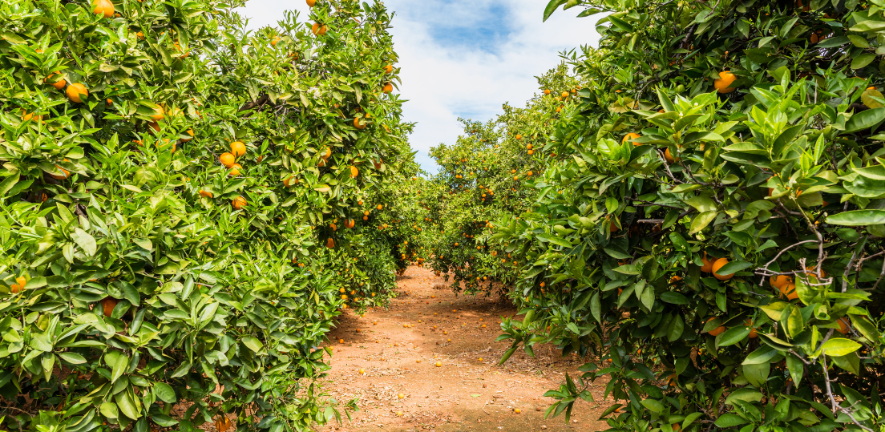
Submitted by Jane Durkin on Mon, 24/02/2025 - 12:25
A tool predicting how to protect European citrus farms from a deadly epidemic shows how mathematical modelling can help prepare for future plant disease invasions.
Citrus greening or huánglóngbìng (HLB) is the most damaging disease of citrus worldwide.
Citrus production in Florida has decreased by 80% since 2005, and experts estimate the United States citrus industry is losing over three billion dollars a year because of the disease.
While it has had a devastating impact on citrus farming in the USA and Brazil for decades, Europe is currently unaffected by the disease.
However, there are increased concerns of an infestation in Europe after psyllids – a type of insect which can spread the bacterial pathogen which causes the disease – have been found in key citrus-producing countries including Portugal and Spain.
Spain is the largest citrus producer in Europe and the sixth largest grower worldwide. An outbreak of citrus greening could cause significant harm to citrus production in the European Union (EU).
In response to this threat, a new study involving researchers at the University of Cambridge uses mathematical modelling to test a range of strategies for detecting and controlling the disease in Europe.
The study has found that early detection, including identifying non-symptomatic infection, and effective pest control will be key to reducing the impact of the disease in European citrus producing regions.
The research was published in Plants, People Planet on 24 February 2025.
Planning for future plant disease epidemics
This study illustrates how mathematical modelling can play a key role in planning for any potential future plant disease epidemic.
Widespread plant disease threatens food security and disturbs important ecosystem services such as flood control and climate regulation. Emerging pathogens, which cause disease in new locations or on new plant host species, can be particularly damaging.
Modelling allows policy makers and other stakeholders to understand how a plant disease might spread and to answer questions about the best approach to detect and control an outbreak. This is becoming more important as plant disease invasion rates rise, driven by factors such as climate change, new farming practices, and increased travel and trade.
Professor Nik Cunniffe, head of the Theoretical and Computational Epidemiology group at the University of Cambridge and last author of the paper said “Modelling provides a rational basis to integrate various sources of uncertainty and to make predictions about the future spread, detection and control of a complex biological system.”
“For emerging pathogens – those which cause disease in new places, or on new host species – modelling has very often been done retrospectively. Too often the story is very late detection of a pathogen and bungled or sometimes non-existent attempts to control.”
“Here we focus on modelling in advance of an invasion and show that models can make a useful contribution in terms of translating information on spread elsewhere to recommendations for disease management even for a pathogen that has not yet entered.”
Implications for protecting citrus in Europe
The research shows that early detection of citrus greening in Europe is key.
Once the disease reaches the EU, without disease management the team predict that large areas will become infected within 10 to 20 years. Even with significant visual surveillance, the epidemic would already be widespread on first detection, making eradication very unlikely.
Removing infected fruit trees and intensive insecticide use could sustain some citriculture for a decade or more, albeit with reduced production. However, effective control may require chemical application rates or active substances no longer authorised in the EU.
The study shows that strategies targeting non-symptomatic infection will be most successful.
One promising solution is to test psyllids to see if they are carrying bacteria which causes the disease. This could be effective early-warning mechanism before plants show symptoms of infection and could reduce lags before disease management starts.
If detection of insects carrying citrus greening were followed by intensive insecticide sprays as well as tree removal, this could greatly improve outcomes.
Professor Cunniffe has recently been appointed as a member of the EFSA (European Food Safety Authority) Panel on Plant Health, whose scientific advice would likely be a key part of any response by EU member states.
Next steps
Modelling work for citrus greening is now being extended at the University of Cambridge by Laura Erbetta, a PhD student in the Theoretical and Computational Epidemiology group at the Department of Plant Sciences.
The idea is to generalise the model of citrus greening to other countries and to other species which transmit the disease – in particular the Asian Citrus Psyllid which has recently invaded Cyprus.
The project will also test more elaborate strategies for detection and control. Particularly exciting would be testing those based on epidemiological risk, or accounting in more detail for behaviour of individual growers.
Funding and collaborators
This paper was written in collaboration with researchers from the University of Warwick in the UK, the Institut Valencià d’Investigacions Agràries (IVIA) in Spain and Universidade do Algarve and Instituto Politecnico de Braganca in Portugal.
The work was led by Dr John Ellis, a former Research Associate in the Department of Plant Sciences at the University of Cambridge, now working on modelling infections of humans in Africa at Imperial College London.
This research was funded by a Horizon 2020 grant, Preventing HLB epidemics for ensuring citrus survival in Europe.
Reference: Ellis, J et al.: Developing epidemiological preparedness for a plant disease invasion: modelling citrus huánglóngbìng in the European Union. Plants, People, Planet, 1-21. https://doi.org/10.1002/ppp3.10643
Image: Orange orchard in Alzira, Valencia Provence, Eastern Spain. Getty images. Credit © Allard Schager.
